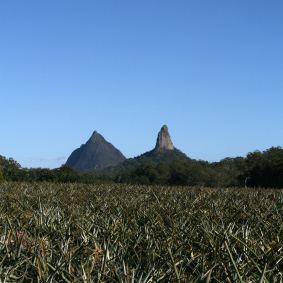Population 5,945 (2011 census) Local time Thursday 6:54 AM | Postcode(s) 4519 Postal code 4519 Parish Bribie Island | |
 | ||
Weather 22°C, Wind S at 6 km/h, 94% Humidity Points of interest Australia Zoo, Mill Park DOG PARK, Mt Coochin | ||
Beerwah (/ˈbɪərwɑː/ or /ˈbɪərwɔː/) is a rural town and a locality in the hinterland of the Sunshine Coast Region, Queensland, Australia. It is situated north of Glass House Mountains, approximately 80 kilometres (50 mi) north of Brisbane, and just south of Landsborough. The main road through Beerwah is called Steve Irwin Way. It was formerly known as the Glasshouse Mountain Tourist Route and is accessed by the Bruce Highway, which bypassed the town in 1985. Beerwah is administered by the Sunshine Coast Regional Council. At the 2006 census, Beerwah had a population of 1,626, with a further 2,636 people living in the surrounding locality.
Contents
- Map of Beerwah QLD 4519 Australia
- History
- Transport
- Tourism
- Education
- Demographics
- Notable residents
- References
Map of Beerwah QLD 4519, Australia
History
The name Beerwah comes from the Kabi language (Turrbal dialect) word birrawaman, with birra meaning sky and wandum meaning climbing up.
Beerwah Post Office opened by August 1907 (a receiving office had been open from 1891).
The Coochin Creek Provisional School opened in November 1888, becoming Coochin Creek State School on 1 January 1909. In about November 1928, it was renamed Beewah State School. On 10 July 1952, another Coochin Creek State School opened, but it closed on 11 March 1962.
Beerwah State High School opened on 1 January 1992.
Transport
Beerwah is a growing hinterland town. Transport links to Brisbane and northbound destinations at Beerwah railway station on the Nambour and Gympie North railway line.
A small bypass was constructed south of the town, including an overpass of the railway, a large roundabout at Roberts Road, and traffic signals at Kilcoy-Beerwah Road and Steve Irwin Way. This work opened to traffic in October 2009. As part of that project, however, the original level crossing was closed and demolished, causing concern amongst local residents who claimed it sliced the town in two. In 2010, many residents began to complain about the lack of signage to the town centre.
Tourism
Australia Zoo is located in Beerwah. The zoo set up by Bob Irwin and later made famous by his son, Crocodile Hunter Steve Irwin. Australia Zoo has brought many visitors to the town of Beerwah and has been named Australia's major tourist attraction many times.
Another tourist attraction, the Glass House mountain range, is located nearby. The largest mountain in the range is Mount Beerwah 555m tall. Access to the Mount Beerwah summit route has been closed since 2008 due to the erosion and destabilisation of some walking tracks, leading to a high risk of rock fall. Glasshouse Mountains Tourist Drive has become quite the attraction. The Big Mower, one of Australia's big things, is located in Beerwah.
Education
Beerwah has three schools: Beerwah State School, Beerwah State High School, and Glasshouse Christian College, a private college.
Demographics
In the 2011 census, Beerwah recorded a population of 5,945 people, 52% female and 48% male.
The median age of the Beerwah population was 38 years, compared to the national median age of 37.
78.1% of people living in Beerwah were born in Australia. The other top responses for country of birth were England 6.1%, New Zealand 4.8%, Scotland 0.6%, Germany 0.5%, Philippines 0.4%.
92.1% of people spoke only English at home; the next most common languages were 0.3% German, 0.3% Dutch, 0.2% Afrikaans, 0.2% Tagalog, 0.2% Italian.
